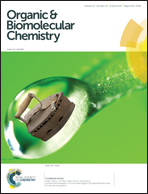Efficacious redox-responsive gene delivery in serum by ferrocenylated monomeric and dimeric cationic cholesterols†
Abstract
Herein, we present the design and synthesis of new redox-active monomeric and dimeric (gemini) cationic lipids based on ferrocenylated cholesterol derivatives for gene delivery. The cationic cholesterols are shown to be transfection efficient after being formulated with the neutral helper lipid DOPE in the presence of serum (FBS). The redox activity of the resulting co-liposomes and their lipoplexes could be regulated using the alkanyl ferrocene moiety attached to the ammonium head groups of the cationic cholesterols. Atomic force microscopy (AFM), dynamic light scattering (DLS) and zeta potential measurements were performed to characterize the co-liposomal aggregates and their complexes with pDNA. The transfection efficiency of lipoplexes could be tuned by changing the oxidation state of the ferrocene moiety. The gene transfection capability was assayed in terms of green fluorescence protein (GFP) expression using pEGFP-C3 plasmid DNA in three cell lines of different origins, namely Caco-2, HEK293T and HeLa, in the presence of serum. The vesicles possessing ferrocene in the reduced state induced an efficient transfection, even better than a commercial reagent Lipofectamine 2000 (Lipo 2000) as evidenced by flow cytometry and fluorescence microscopy. All the co-liposomes containing the oxidized ferrocene displayed diminished levels of gene expression. Gene transfection events from the oxidized co-liposomes were further potentiated by introducing ascorbic acid (AA) as a reducing agent during lipoplex incubation with cells, leading to the resumption of transfection activity. Assessment of transfection capability of both reduced and oxidized co-liposomes was also undertaken following cellular internalization of labelled pDNA using confocal microscopy and flow cytometry. Overall, we demonstrate here controlled gene transfection activities using redox-driven, transfection efficient cationic monomeric and dimeric cholesterol lipids. Such systems could be used in gene delivery applications where transfection needs to be performed spatially or temporally.


 Please wait while we load your content...
Please wait while we load your content...